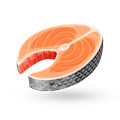One of the most popular fresh seafood one-bowl donburi dishes, kaisendon consists of thinly sliced, assorted raw seafood called sashimi laid over freshly steamed rice. What kind of sashimi will be used in a kaisendon dish is not fixed, but the seafood selection depends on both location and season, and most often includes maguro (tuna), tai (sea bream), ama ebi (deep-water shrimps), hotate (scallops), uni (sea urchin), kani (crab), and sometimes even marinated ikura (salmon roe).
Apart from sashimi, kaisendon is typically topped with toasted nori seaweed, myoga ginger, shiso or Japanese basil, cucumber, onions, and either fresh or pickled ginger. Before being placed on a bed of steamy rice, all of the ingredients are drizzled with wasabi-laced soy sauce, and the kaisendon bowl is lastly garnished with some white sesame seeds, white radish sprouts, and wasabi paste.
MOST ICONIC Kaisendon
View moreMAIN INGREDIENTS
Chutoro nigiri sushi is a traditional type of nigiri sushi. It consists of hand-pressed sushi rice that's topped with slices of medium-fatty cuts of tuna. Different cuts of tuna are classified as otoro (fatty), chutoro (medium-fatty), and akami (red meat).
The dish has a rich and deep flavor and a soft texture. Traditionally, this type of sushi is eaten by hand in a single bite. It's usually accompanied by soy sauce, wasabi, or pickled ginger (gari) on the side.
MOST ICONIC Chutoro nigiri sushi
View moreNigiri or nigirizushi is a special kind of hand-pressed sushi where the meat is sliced and pressed on top of sushi rice. It was developed in Tokyo (then called Edo) during the 1800s. Sometimes, nori seaweed is used to wrap the whole concoction and keep it together.
The topping is usually seafood such as shrimp, tuna, haddock, or eel, and it should always be fresh and of the highest quality. Traditionally, nigirizushi is paired with shiso leaves, wasabi, soy sauce, or pickled ginger. It is sometimes garnished with daikon and salted seaweed.
VARIATIONS OF Nigiri
MOST ICONIC Nigiri
View moreUnadon is a Japanese dish consisting of grilled unagi (eel) fillets placed on top of steamed rice. The eel is grilled kabayaki-style, where the fish is split, gutted, butterflied, cut into squares, skewered, then diped in tare sauce before being grilled.
The tare sauce consists of soy sauce, mirin, sugar, and sake. It provides the necessary caramelization to the fish during the grilling process. Before serving, unadon is typically garnished with sanshō berries on top. In Kantō, the eel is traditionally steamed before grilling, resulting in a more tender texture of the fish, while in Kansai, the eel is simply grilled without prior steaming.
Maguro nigiri sushi is a traditional type of nigiri sushi. It consists of hand-pressed sushi rice that's topped with slices of tuna. Different cuts of tuna are classified as otoro (fatty), chutoro (medium-fatty), and akami (red meat).
The dish has a mild flavor and a rich texture that makes it great for sushi newcomers. Traditionally, this type of sushi is eaten by hand in a single bite. It's usually accompanied by soy sauce, wasabi, or pickled ginger (gari) on the side.
VARIATIONS OF Maguro nigiri sushi
MOST ICONIC Maguro nigiri sushi
View moreMAIN INGREDIENTS
Tekkadon is a simple Japanese dish that consists of steamed, vinegar-flavored rice that is topped with pieces of sashimi-style, raw tuna. The dish is often garnished with strips of nori seaweed and sliced scallions and is usually served with a soy sauce on the side.
The term is sometimes used interchangeably with maguro zuke don—a similar dish that incorporates marinated pieces of tuna and which is usually served without a dipping sauce on the side. Tekkadon belongs to the group of donburi dishes, and it can be enjoyed as a light main course.
MAIN INGREDIENTS
Otoro nigiri sushi is a traditional type of nigiri sushi. It consists of hand-pressed sushi rice that's topped with slices of fatty cuts of tuna. Different cuts of tuna are classified as otoro (fatty), chutoro (medium-fatty), and akami (red meat).
The dish has a rich flavor and a melt-in-the-mouth texture that makes it quite expensive. Traditionally, this type of sushi is eaten by hand in a single bite. It's usually accompanied by soy sauce, wasabi, or pickled ginger (gari) on the side.
MOST ICONIC Otoro nigiri sushi
View moreMAIN INGREDIENTS
Sashimi is a Japanese delicacy consisting of thinly sliced raw fish or shellfish (or even meat) served with soy sauce and other ingredients such as wasabi or ginger paste. Most common ingredients used in the preparation of sashimi are tuna, squid, scallop, whale, and octopus.
Sashimi can be cut in different ways to alter the appearance of the dish, from extremely thin to very thick slices of fish. It is usually served as an appetizer, decorated with shiso leaves, cucumbers, and seaweed (wakame and tosaka-nori).
VARIATIONS OF Sashimi
MOST ICONIC Sashimi
View moreMAIN INGREDIENTS
These large prawns are typically dipped in egg wash, coated in panko breadcrumbs, then deep-fried. They are one of the most popular yōshoku dishes; western-inspired Japanese meals which originated during the Meiji Restoration between the 1860s and the early 1900s.
Ebi furai falls into the kawari-age category of breaded, deep-fried foods, and it is also regarded as a meibutsu, which is a Japanese term for famous foods associated with particular regions, as these fried prawns are one of Nagoya's signature dishes.
Sake nigiri sushi is a Japanese type of nigiri sushi, with origins in Norway. It consists of hand-pressed sushi rice that's topped with slices of salmon. The dish has a soft texture and a clean finish that makes it good for sushi newcomers, although the flavor can be a bit fishier than maguro (tuna) nigiri sushi.
Traditionally, this type of sushi is eaten by hand in a single bite. It's usually accompanied by soy sauce, wasabi, or pickled ginger (gari) on the side.
TasteAtlas food rankings are based on the ratings of the TasteAtlas audience, with a series of mechanisms that recognize real users and that ignore bot, nationalist or local patriotic ratings, and give additional value to the ratings of users that the system recognizes as knowledgeable. For the “Top 55 Japanese Seafood Dishes” list until March 21, 2025, 3,928 ratings were recorded, of which 3,376 were recognized by the system as legitimate. TasteAtlas Rankings should not be seen as the final global conclusion about food. Their purpose is to promote excellent local foods, instill pride in traditional dishes, and arouse curiosity about dishes you haven’t tried.





















































